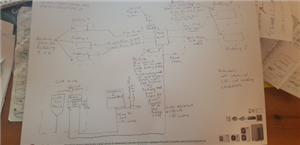Hope you are well - just looking for a bit of guidance on bonding on a job - schematic picture attached.
Basically, 200A head to busbar chamber (TNCS)
63A SPN switch fuse to Building 1 - a big metal shed - 35mm buried SWA 3 core. For main bonding, I understand I have to put 35mm bonds to metalwork. Incoming pipes are plastic. Will I need to bond the incoming BT? Single copper line off the road.
200A isolator to central plant room - 185m away with a 200A MCCB board. This is to feed 5 buildings inc. a 3 phase. Plant room will have an MCB board also for external lighting and air con units which will serve 2 buildings via buried refrigerant pipe. Also a booster pump with metal pipework which is plastic as it leaves/enters the room. Also a central TV/radio system to feed coax out to the 5 buildings fed from here.
As I understand, I need to do 35mm bonds for structure, air con, and also BT incomer and aerial. Believe latter two to be 6mm? Also supplementary 2.5mm bonds for pipes, pumps, metal door frames.
All 5 properties fed from plant room have 35 or 50mm feeds and I understand these all need 35 main bonds for structure, AC pipes (where fed from ac outdoor units at plant room). For coax and BT cables - 6mm bonds?
In a nutshell - am I correct in my understanding of the bonding sizes, in particular telecoms and BT feeds? Using combined CPC and bonding conductors. I tend to see 6mm for comms and TV stuff.
A sanity check would be very welcome.
Regards
Muhammad

